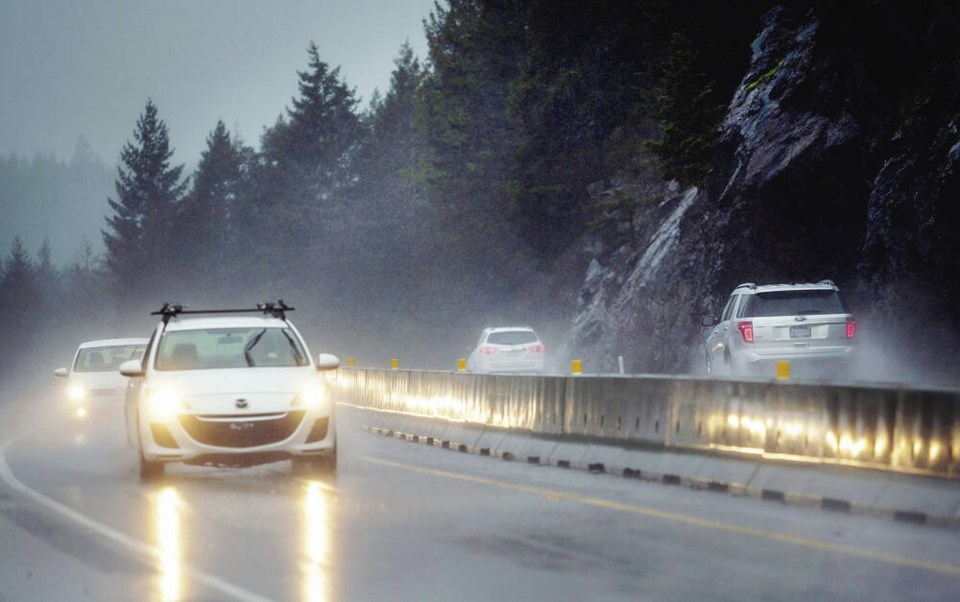I had to go to Nanaimo last week during one of our classic late-fall rainstorms. The Malahat is a tricky piece of highway driving when conditions are perfect. Add some rain and it very quickly borders on treacherous.
So I’m still amazed how many drivers treat this area with indifference, especially during bad weather. It’s not unusual to be passed by vehicles doing 10 or 20 kilometres over the limit despite the fact that this rain-slicked area has chopped their visibility and reaction times in half.
Hydroplaning is a serious issue on a wet road. Most drivers already understand what’s going on there but for those who may not, this is a condition created by tires running over that thin layer of water on the road. That thin layer of road water covers the tire tread and in effect creates a layer between the rubber and the road itself. Gliding on it can have a serious impact on your vehicle’s traction and steering control.
Sudden movements to correct a slip during hydroplaning can be deadly. Instead, keep calm, get off the gas and steer smoothly. Brake firmly but not excessively until you regain control.
There’s often a temptation at times to drive into large puddles. That’s a really bad idea, especially in areas that aren’t familiar to you. You can’t tell how deep a puddle is from behind the wheel and you have no idea what lurks beneath.
Every major flood story in the news probably includes a person being rescued from the roof of their vehicle after they tried to experiment with a large pool of water on the road. Aside from the risk to life, deep water immersion can permanently destroy your vehicle’s electrical system.
If you’ve had to navigate a lot of water on a piece of roadway, it’s a good idea to check your brakes. Wet brakes generally do not work as well as dry ones, although I’ve found more than a few times that wet brakes can grip excessively at first, causing rapid deceleration and wheel lock. Not good on a wet road. Experts advise that light brake pressure applied for a short time is a good method to dry them off.
There also may be the rare time when you come across deeper water actually flowing across a roadway — or where a roadway might have been before. Don’t cross it. Lessons learned from B.C.’s atmospheric river of November 2021 tell us that you can’t estimate the depth or the power of water flow just by looking at it.
According to the U.S. National Weather Service, six inches of fast flowing water can sweep away an adult. Twelve inches is sufficient to move a car and just under two feet can propel large pickup trucks. Their advisory is: “Turn around and don’t drown”.
On the Malahat last week I also saw people travelling in the blindspots of large vehicles. This is dangerous at the best of times, but doubly so in the rain. Large vehicles whip up much more spray and road debris, impairing vision even further. Large vehicle drivers are suffering from the same weather vision impairment as you. You can be next to invisible in their blindspots. Pass these vehicles as safely as possible or stay well behind — never travel in their blindspots.
I’ve run into two scenarios in my driving life where there’s so much rain that vehicle wipers were useless — once while travelling in Mississippi and once just outside of Fort Steele, B.C. Experts agree that if your visibility is zero or even greatly reduced, pull over, stop and turn on your hazard lights. That seems like total common sense yet on both occasions when I ran into these problems cars continued to pass by — some maintaining highway speed.
Finally, brake early rather than later in wet weather. Reducing your speed further back gives you much more control as you pull up behind stopped vehicles. Early braking, with steady and slower pressure on the pedal, warns drivers behind that you are slowing, dries your brakes and lessens the impact of a collision should things go wrong.
Glove Box: Peekskill, New York has never been the centre of automotive news, except maybe once. On Oct. 9, 1992 a 1980 Chevy Malibu parked at the home of Michelle Knapp, who had just bought the car, was struck by a 26 pound meteorite. They were sturdy cars, but this one was no match for an interstellar projectile estimated to be 4.4 billion years old — travelling at 300 km/h, which sliced through the trunk. The Malibu is now a museum piece exhibited around the world. Fortunately, scientists estimate the odds of a car being struck by a meteorite at 100 billion to one.



